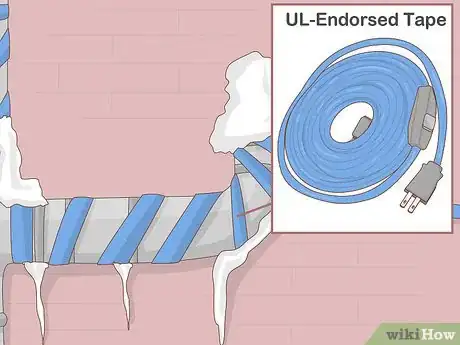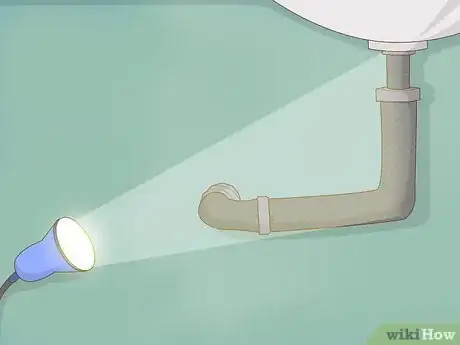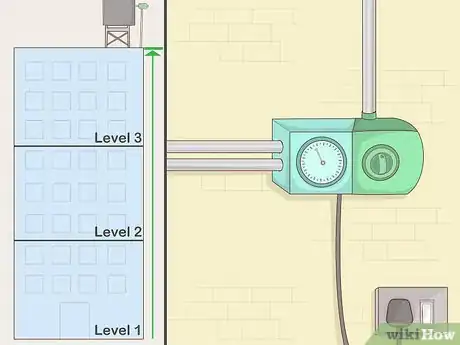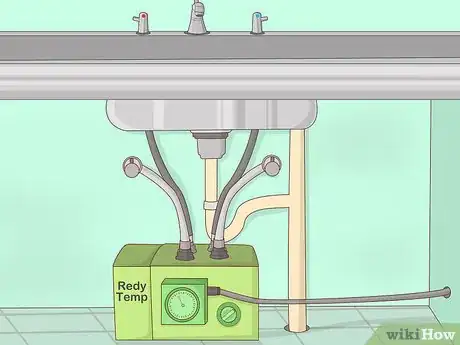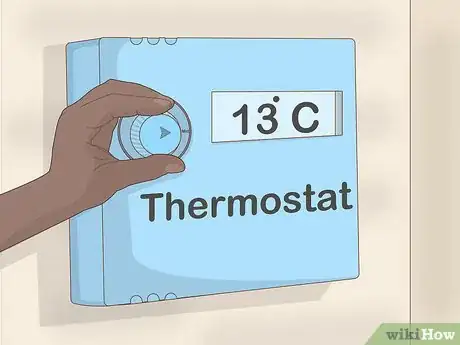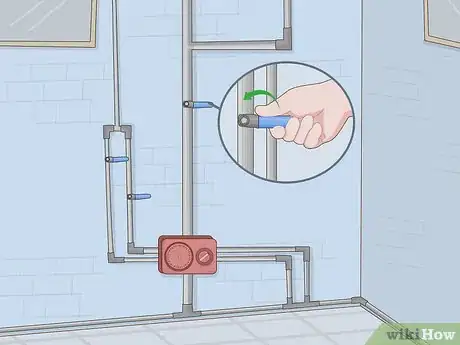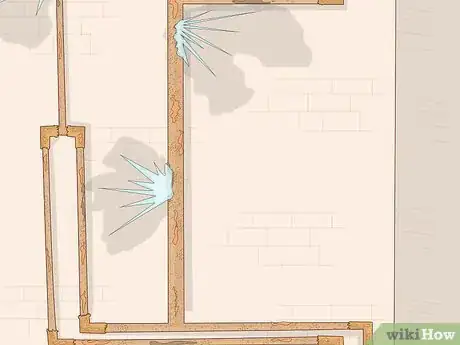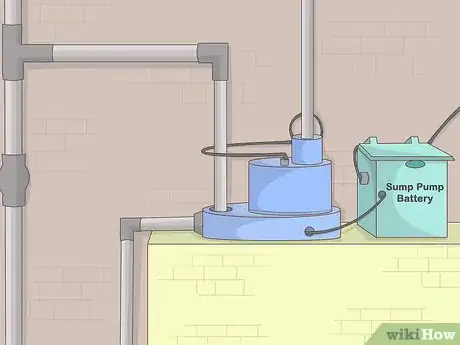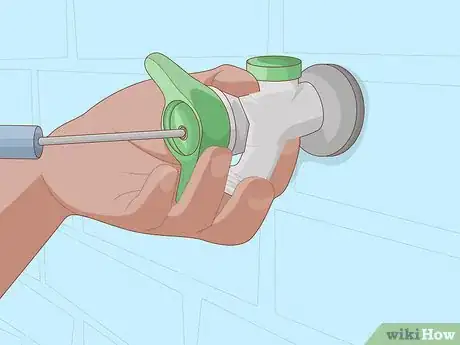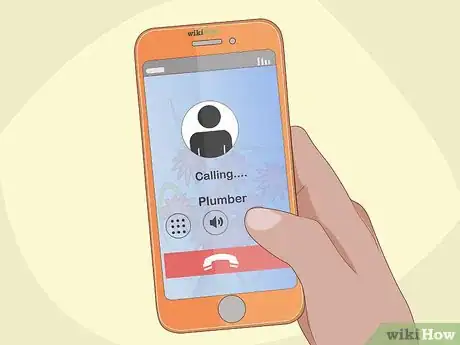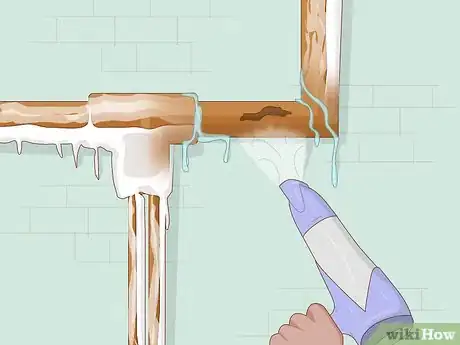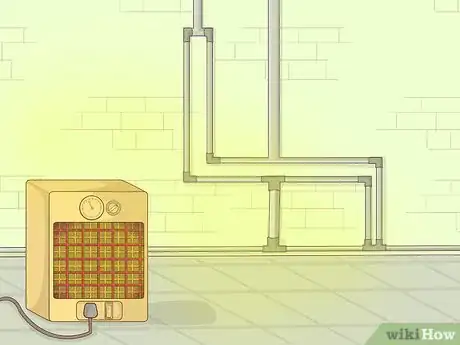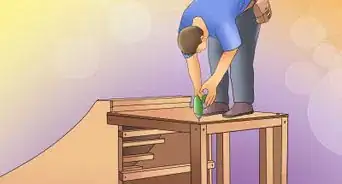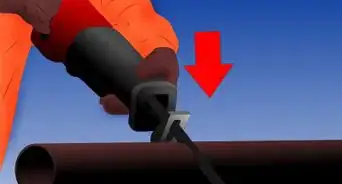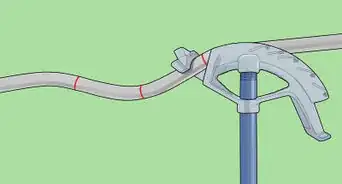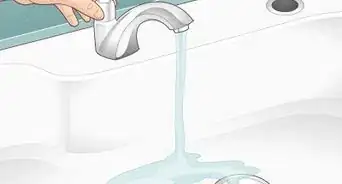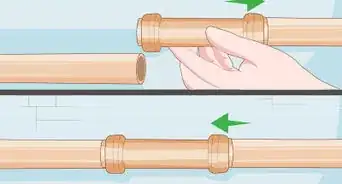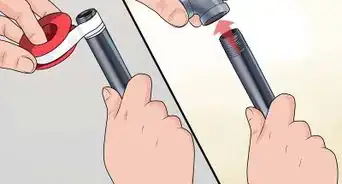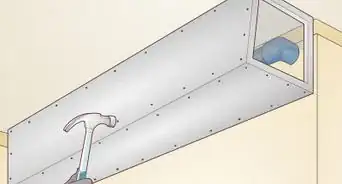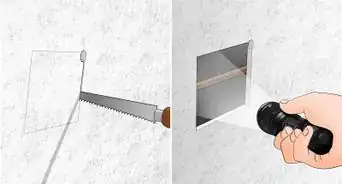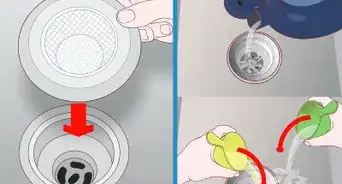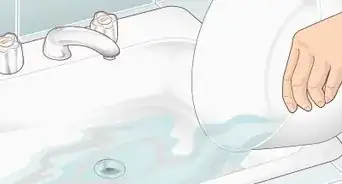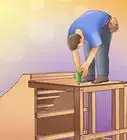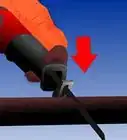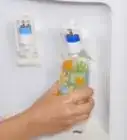This article was co-authored by David Balkan. David Balkan is a Professional Plumber, CEO of Balkan Sewer and Water Main Service, and President of Balkan Sewer and Drain Cleaning. As a hands-on owner of these companies for over 40 years, David is knowledgeable about water service lines, sewers, and drain line issues. David is a Committee Chairman of the Master Plumbers Council and has sat on the Executive Committee of the Sub Surface Plumbers Association of New York for over 30 years. His knowledge and solution-oriented approach contributed to Balkan Sewer and Water Main Service being the largest and most trusted service in New York City and the recipient of the 2017 Angie’s List Super Service Award.
There are 11 references cited in this article, which can be found at the bottom of the page.
wikiHow marks an article as reader-approved once it receives enough positive feedback. In this case, 89% of readers who voted found the article helpful, earning it our reader-approved status.
This article has been viewed 885,492 times.
Water expands when it freezes into ice. Unfortunately, water pipes (usually metal or plastic) don’t. This puts a frozen water pipe in danger of bursting, causing a costly mess. The good news is that you can prevent pipes from freezing in the first place by keeping them warm. If you’re leaving for an extended period of time in the winter, you can and should drain your water lines. On the other hand, if a deep freeze hits your pipes before you can take action, you can thaw them safely.
Steps
Keeping the Pipes Warm
-
1Wrap heater tapes around the pipes. Buy UL-endorsed tape with a built-in thermostat. This safety precaution will prevent the tape from overheating. You can either wrap the tape around the pipes or run them along the length of the pipes. Follow the manufacturer’s instructions to use the tape.[1]
- While you can lay insulation over some tapes, others might cause the insulation to catch fire. Always read the safety information before installing the tape.
- Alternatively, you could use a heated reflector lamp in a dry enclosed space. On cold nights, check the light to see that it is working.[2]
-
2Insulate all water pipes from cold moving air. Wrap pipes in foam rubber insulation designed for pipes. Make sure that there aren’t any gaps between the pipe and the insulation. Miter any strips of insulation that meet at the corners of pipes. Secure them with duct tape. Keep the foam dry as you insulate.
- When the temperature drops below freezing, leave doors to cabinets or closets with plumbing open at night. This will allow warmer air to circulate, preventing them from freezing.
- Insulation alone doesn’t prevent freezing. It only slows down the transfer rate of heat to cold.[3]
Advertisement -
3Insulate and heat the drain lines. Apply foam rubber insulation in the same way you insulated the pipes. Pay attention to bathroom and kitchen sinks. Don’t overlook lines in crawl spaces and cold basements. On especially cold days, direct a heat lamp on the drain P-trap.[4]
- If you’re concerned about a fire hazard, keep the cabinet doors beneath the kitchen and bathroom sinks open to allow warm air to circulate around the pipes.
-
4Open the tap on cold days without power. If you lose electric power, let the water run no faster than a slow constant drip. This is cheaper than repairing a burst pipe. First, start a slow drip on the hot side faucet, then a faster drip on the cold side faucet. There is no need to run a lot of water. Bathrooms can be cold, as long as they aren't freezing.
-
5Use a thermal convection-powered hot water recirculation valve. This doesn’t require electricity to operate. It bypasses the drain and continuously circulates warm water through the waterlines. Turn the water off at the main source before installing. Remove the valves under the sink with a mini hacksaw. Use the included connecting joints to attach the valve to the copper fitting from the wall. Secure the fittings to the pipes with a wrench. Switch off the valve whenever you don’t want the water to circulate.
- This method requires that the valve be installed at a higher level (usually the second or third floor) than the water heater.
- Circulating water throughout your system non-stop will also increase your water heating bill.[5]
-
6Fill any drafty gaps or cracks near the pipes. Small holes, cracks, and gaps can bring cold air into your home that might freeze your pipes, even if the rest of your home is warm. Check the areas around your plumbing to make sure that there are no drafts coming in. If you find one, close it with caulk to prevent cold air from coming inside.
-
7Use a RedyTemp. This device uses an internal water contacting temperature probe to monitor the water temperature inside the pipes. Disconnect one end of the existing faucet supply lines. Attach them to the RedyTemp. Connect the two faucet supply lines that come with the device. Plug the unit into a standard wall socket and set the desired temperature set point.
- Gauge the effectiveness of your chosen set point by opening cold water faucets upstream and feeling how cool or warm the water is coming out the tap. Adjust the set point accordingly until optimized. You’ll achieve an optimized set point when cool or warm water stays in the cold water pipes or the portion of pipe requiring protection.
- If you own a tankless on-demand water heater, you’ll need the TL4000 series model rather than the more common ATC3000. During off seasons when you don’t need circulation, lower the temperature set point.
-
8Adjust the thermostat. Set the home or structure's thermostat to at least 55 °F (13 °C). This will keep the temperature well above the freezing point of water. It will also allow enough warm air to circulate to the attic and behind walls, where pipes are often located.[6]
Draining Your Water Lines
-
1Locate the main water supply. This consists of two parts. You should find one part near the meter on the street side of your house. The location of the second part depends on where you live. If you live in a warm climate, look on an outside wall or in an underground box. If you’re in a colder climate, look in the basement.[7]
-
2Turn off the main water supply. First, open all faucets in the house. Then, shut down both parts of the valve.[8] Make sure that the water flow coming from the faucets stops after a few minutes. If it doesn’t, re-check both parts of the valve and tighten them as best as you can. Call a plumber if you can’t shut off the valve or if any part of the valve breaks.
- If you receive well water, turn off its electrical switch to prevent the well from pumping water inside.[9]
-
3Shut off secondary supply valves. Take this step if you have automatic outdoor watering systems that prevent you from shutting off the main water supply. Look for round or oval handles. Turn the handles clockwise (“righty tighty”) to close the valves. Shut off valves to appliances involved in significant drainage. These include:
- The dishwasher
- The washing machine
- The ice maker on the refrigerator
- Look for this valve either under the sink or in the basement.[10]
-
4Inspect the supply lines. Look for leaks, rust, cracks, and other evidence of damage. If any areas are damaged, replace them with hoses coated in braided stainless steel. These are more durable than rubber hoses. Call a plumber if you need assistance.[11]
-
5Treat the sump pump. Add a battery backup to the pump in the event of a power failure. Pour water into the pit. It should drain the water by itself. If it doesn’t, make sure the pump is plugged in and the breaker is switched on. If it’s still not working:
- Make sure the motor is running normally.
- Check the pipe for evidence of freezing or clogging.
- Clean the discharge line.
- Call a plumber if all else fails.[12]
-
6Disconnect watering implements from your outdoor faucet. This includes the hose and the sprinkler. Disconnect everything in the winter or before the temperature in your area drops below freezing.[13] The water inside the hose can freeze and back up into the faucet until it reaches your pipes. Any pipe that freezes can burst.
- You can also replace your faucet with one that prevents the water inside the house from reaching the cold exterior. These frost-free spigots are level with the connecting pipe.[14]
- Another option is to get a hose bib vacuum breaker from a hardware store. These screw directly onto the existing faucet to prevent contamination and freezing.
-
7Treat the exterior faucet. You can protect it from causing problems in one of three ways:
- Wrap it in foam rubber insulation.
- Open the faucet to drain any excess water from the connecting pipes.
- Replace it with a spigot that shuts off the supply of water to pipes in the walls.[15]
-
8Call a plumber. If you live in an especially cold climate, ask a plumber to inspect your work to make sure you left no loose ends. Have them also drain the water heater. For an added bit of precaution, you could also ask them to empty water left in drains and traps and replace it with non-toxic antifreeze.[16] [17]
Thawing Frozen Pipes
-
1Locate the frozen pipe. Turn on each faucet one by one. If none of your faucets works, the frozen pipe is close to or right at the main water supply, usually located on the street side of your basement or in an uninsulated crawl space. Run your hands every few feet along the pipe to find a section that feels very cold. This is the frozen section.[18]
- If water flows from some faucets but not others, the problem might be in a pipe connected to a specific faucet or a pipe on one side of the house. Check pipes in uninsulated walls first.
- Keep all frozen taps open until water starts to flow. Then, lower the water to a trickle.[19]
-
2Check the pipe in the area of the freeze. Some plastic or copper pipes will split. This will flood the area when thawed. If the pipe looks burst or has a slit in it, call a plumber immediately. Turn off the water supply, as well as the water heater.[20] If there are no splits, begin the thawing process.
-
3Heat the area around the frozen part. Use an electric space heater, a hair dryer, or a heat lamp in a reflector to prevent a fire. Exercise caution when placing heat-generating devices. Never leave these devices unattended for any amount of time when in use. If you have a problem, call the plumber.
- Space heaters, heat lamps, and reflective lamps can generate high temperatures, which might cause flammable materials to combust. If you need to place a heat source under the kitchen sink, remove all chemicals first.[21]
- Never put heaters in crawl spaces or in small spaces. These could cause a fire.
Expert Q&A
-
QuestionHow can I protect my pipes if my house isn't heated?
 David BalkanDavid Balkan is a Professional Plumber, CEO of Balkan Sewer and Water Main Service, and President of Balkan Sewer and Drain Cleaning. As a hands-on owner of these companies for over 40 years, David is knowledgeable about water service lines, sewers, and drain line issues. David is a Committee Chairman of the Master Plumbers Council and has sat on the Executive Committee of the Sub Surface Plumbers Association of New York for over 30 years. His knowledge and solution-oriented approach contributed to Balkan Sewer and Water Main Service being the largest and most trusted service in New York City and the recipient of the 2017 Angie’s List Super Service Award.
David BalkanDavid Balkan is a Professional Plumber, CEO of Balkan Sewer and Water Main Service, and President of Balkan Sewer and Drain Cleaning. As a hands-on owner of these companies for over 40 years, David is knowledgeable about water service lines, sewers, and drain line issues. David is a Committee Chairman of the Master Plumbers Council and has sat on the Executive Committee of the Sub Surface Plumbers Association of New York for over 30 years. His knowledge and solution-oriented approach contributed to Balkan Sewer and Water Main Service being the largest and most trusted service in New York City and the recipient of the 2017 Angie’s List Super Service Award.
Professional Plumber & CEO of Balkan Sewer & Water Main If you have areas of your house that aren't heated, like a water main in your garage, purchase electric heat tape. Wrap it around your pipe then plug it in, and it will keep the line warm enough that it won't freeze.
If you have areas of your house that aren't heated, like a water main in your garage, purchase electric heat tape. Wrap it around your pipe then plug it in, and it will keep the line warm enough that it won't freeze. -
QuestionHow do I protect my outside faucets?
 David BalkanDavid Balkan is a Professional Plumber, CEO of Balkan Sewer and Water Main Service, and President of Balkan Sewer and Drain Cleaning. As a hands-on owner of these companies for over 40 years, David is knowledgeable about water service lines, sewers, and drain line issues. David is a Committee Chairman of the Master Plumbers Council and has sat on the Executive Committee of the Sub Surface Plumbers Association of New York for over 30 years. His knowledge and solution-oriented approach contributed to Balkan Sewer and Water Main Service being the largest and most trusted service in New York City and the recipient of the 2017 Angie’s List Super Service Award.
David BalkanDavid Balkan is a Professional Plumber, CEO of Balkan Sewer and Water Main Service, and President of Balkan Sewer and Drain Cleaning. As a hands-on owner of these companies for over 40 years, David is knowledgeable about water service lines, sewers, and drain line issues. David is a Committee Chairman of the Master Plumbers Council and has sat on the Executive Committee of the Sub Surface Plumbers Association of New York for over 30 years. His knowledge and solution-oriented approach contributed to Balkan Sewer and Water Main Service being the largest and most trusted service in New York City and the recipient of the 2017 Angie’s List Super Service Award.
Professional Plumber & CEO of Balkan Sewer & Water Main If your garden hose spigots aren't frost-proof, you have to turn them off from the inside before you have your first frost. Then, drain the water on the outside so it can't freeze.
If your garden hose spigots aren't frost-proof, you have to turn them off from the inside before you have your first frost. Then, drain the water on the outside so it can't freeze. -
QuestionHow do I keep my water meter from freezing?
 David BalkanDavid Balkan is a Professional Plumber, CEO of Balkan Sewer and Water Main Service, and President of Balkan Sewer and Drain Cleaning. As a hands-on owner of these companies for over 40 years, David is knowledgeable about water service lines, sewers, and drain line issues. David is a Committee Chairman of the Master Plumbers Council and has sat on the Executive Committee of the Sub Surface Plumbers Association of New York for over 30 years. His knowledge and solution-oriented approach contributed to Balkan Sewer and Water Main Service being the largest and most trusted service in New York City and the recipient of the 2017 Angie’s List Super Service Award.
David BalkanDavid Balkan is a Professional Plumber, CEO of Balkan Sewer and Water Main Service, and President of Balkan Sewer and Drain Cleaning. As a hands-on owner of these companies for over 40 years, David is knowledgeable about water service lines, sewers, and drain line issues. David is a Committee Chairman of the Master Plumbers Council and has sat on the Executive Committee of the Sub Surface Plumbers Association of New York for over 30 years. His knowledge and solution-oriented approach contributed to Balkan Sewer and Water Main Service being the largest and most trusted service in New York City and the recipient of the 2017 Angie’s List Super Service Award.
Professional Plumber & CEO of Balkan Sewer & Water Main If your water meter is outside the building, you have to make sure it's covered. If it's uncovered, it's going to freeze solid.
If your water meter is outside the building, you have to make sure it's covered. If it's uncovered, it's going to freeze solid.
Warnings
- Never use any kind of open flame. It may burst your pipes.⧼thumbs_response⧽
Things You'll Need
- Pipe insulation
- Heat tape
- Reflector heat lamp
- Hand-held hair dryer
- Thermal convection-powered hot water recirculation valve
- RedyTemp
- Wrench
- Mini hacksaw
References
- ↑ David Balkan. Professional Plumber & CEO of Balkan Sewer & Water Main. Expert Interview. 23 February 2021.
- ↑ https://www.todayshomeowner.com/how-to-prevent-pipes-from-freezing-and-thaw-frozen-pipes/
- ↑ https://www.thisoldhouse.com/how-to/how-to-prevent-frozen-pipes
- ↑ https://www.popularmechanics.com/home/interior-projects/a9934/how-to-winterize-plumbing-pipes/
- ↑ https://www.youtube.com/watch?v=KdA_gfau1s4
- ↑ https://www.houselogic.com/organize-maintain/diy-repair/prevent-freezing-pipes/
- ↑ https://www.familyhandyman.com/plumbing/prevent-water-damage-while-you-are-away/view-all
- ↑ David Balkan. Professional Plumber & CEO of Balkan Sewer & Water Main. Expert Interview. 23 February 2021.
- ↑ https://www.familyhandyman.com/plumbing/prevent-water-damage-while-you-are-away/view-all
- ↑ https://www.familyhandyman.com/plumbing/prevent-water-damage-while-you-are-away/view-all
- ↑ https://www.familyhandyman.com/plumbing/prevent-water-damage-while-you-are-away/view-all
- ↑ https://www.familyhandyman.com/plumbing/prevent-water-damage-while-you-are-away/view-all
- ↑ David Balkan. Professional Plumber & CEO of Balkan Sewer & Water Main. Expert Interview. 23 February 2021.
- ↑ https://www.todayshomeowner.com/how-to-prevent-pipes-from-freezing-and-thaw-frozen-pipes/
- ↑ https://www.todayshomeowner.com/how-to-prevent-pipes-from-freezing-and-thaw-frozen-pipes/
- ↑ David Balkan. Professional Plumber & CEO of Balkan Sewer & Water Main. Expert Interview. 23 February 2021.
- ↑ https://www.houselogic.com/organize-maintain/diy-repair/prevent-freezing-pipes/
- ↑ https://www.bobvila.com/articles/how-to-thaw-frozen-pipes/
- ↑ https://www.oldhouseweb.com/how-to-advice/thawing-frozen-pipes.shtml
- ↑ https://cincinnati-oh.gov/water/leaks-and-breaks/frozen-pipes/
- ↑ https://www.bobvila.com/articles/how-to-thaw-frozen-pipes/
About This Article
To prevent frozen water pipes, keep the pipes warm by wrapping heater tape or foam rubber insulation around them. Fill any drafty gaps or cracks near the pipes with caulk and consider installing a thermal convection-powered hot water recirculation valve if you anticipate a hard or problematic winter ahead. During a hard freeze or if your home loses power, turn the tap on to create a slow, constant drip to prevent frozen pipes! For tips on thawing frozen pipes, read on!
